| Oracle® Retail Integration Bus Cloud Service Installation Guide Release 19.1.000 F31805-01 |
|
 Previous |
 Next |
| Oracle® Retail Integration Bus Cloud Service Installation Guide Release 19.1.000 F31805-01 |
|
 Previous |
 Next |
Perform the following steps to install the RIB application.
Make sure that the JAVA_HOME environment variable is set for the user that will be performing these tasks.
echo $JAVA_HOME /usr/bin/java/jdk1.8.0_64
Example: export JAVA_HOME=/usr/bin/java/jdk1.8.0_64

Make sure that all RIB WebLogic instances that are to be deployed to are running.
Download and extract the RibKer-nel<RIB_MAJOR_VERSION>ForAll<RETAIL_APP_VERSION>Apps_eng_ga.tar.
Copy the latest version to the rib-app-builder and then extract it to build your "rib-home." This "rib-home" will be the directory from where you will perform "all" the rib-<app> related tasks from now on.

directory structure of "rib-home":
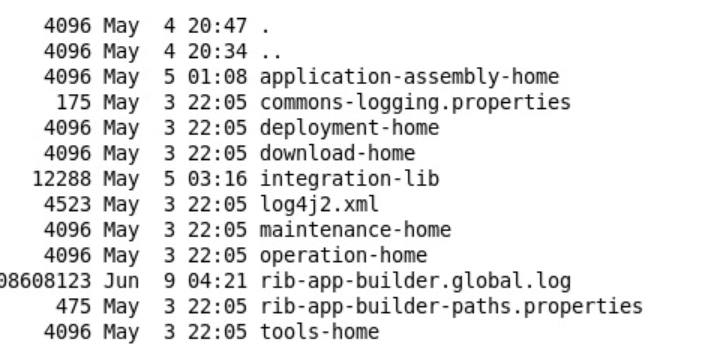
Download the RibFuncArti-fact<RIB_MAJOR_VERSION>ForAll<RETAIL_APP_VERSION>Apps_eng_ga.tar and put it in rib-home/download-home/rib-func-artifacts directory.
|
Note: Do not extract the tar file. This will be done by the check-version-and-unpack tool. |
Example: Directory structure of rib-func-artifacts directory:

Download the RibPak<RIB_MAJOR_VERSION>For<RETAIL_APP_NAME><RETAIL_APP_VERSION>_eng_ga.tar and put it in rib-home/download-home/all-rib-apps directory.
|
Note: Do not extract the tar file. This will be done by the check-version-and-unpack tool. |
Example: Directory structure of rib-func-artifacts directory:

Run the rib-home/download-home/bin/check-version-and-unpack.sh script from rib-home/download-home/bin directory.
This script verifies the version compatibility between the packs and extract the files if they are compatible.

Edit rib-home/deployment-home/conf/rib-deployment-env-info.xml file to specify the deployment environment information.
See the "Information to Gather for Installation in Remote Server" section before starting the edit. This file (rib-deployment-env-info.xml) is the only file that the user has to edit. See the "Rib-app-builder documentation" for details and examples.
The XML file has four major sections.
app-in-scope-for-integration section:
In this section you define what applications are in scope for this environment.
rib-jms-server section:
In this section you define the JMS server information.
|
Note: See also"Preinstallation Steps for Multiple JMS Server Setup" in Chapter 4 of this guide. |
rib-javaee-containers section:
In this section you define the "Java EE container information" for each of the rib-<app> that are in scope.
rib-applications section:
In this section you define the rib-<app> specific information for each of the rib-<app> that are in scope.
For PL/SQL applications you must define RIB Hospital connection and email notification information.
For Java EE applications you will need to define RIB Hospital connection, email notification information and the connecting retail application's (for example, <app>) JNDI information.
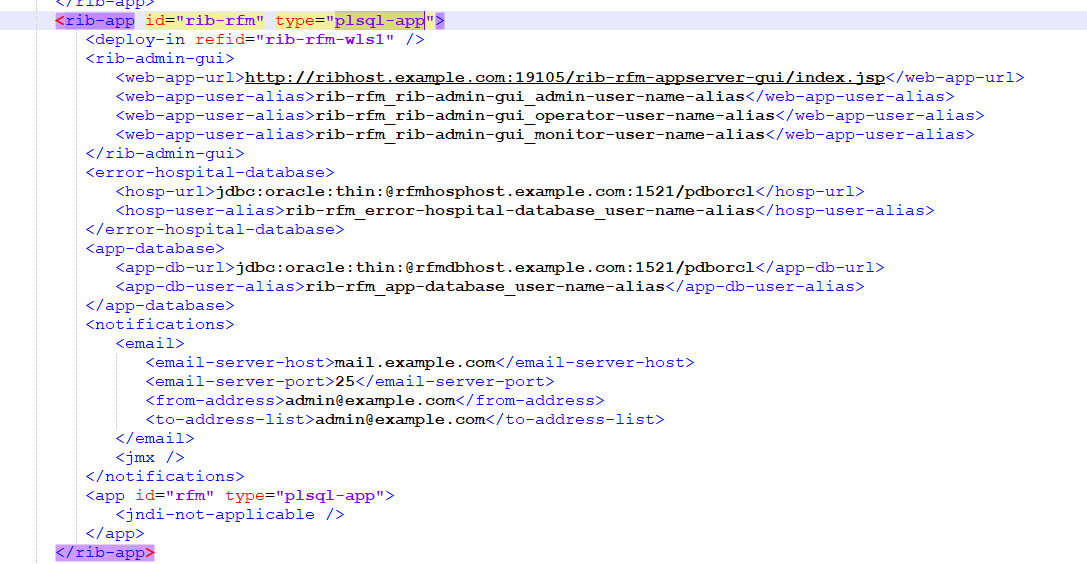
Edit the app-in-scope-for-integration section to match the desired deployment. Define what applications are in scope for this environment.

Edit the application server section.
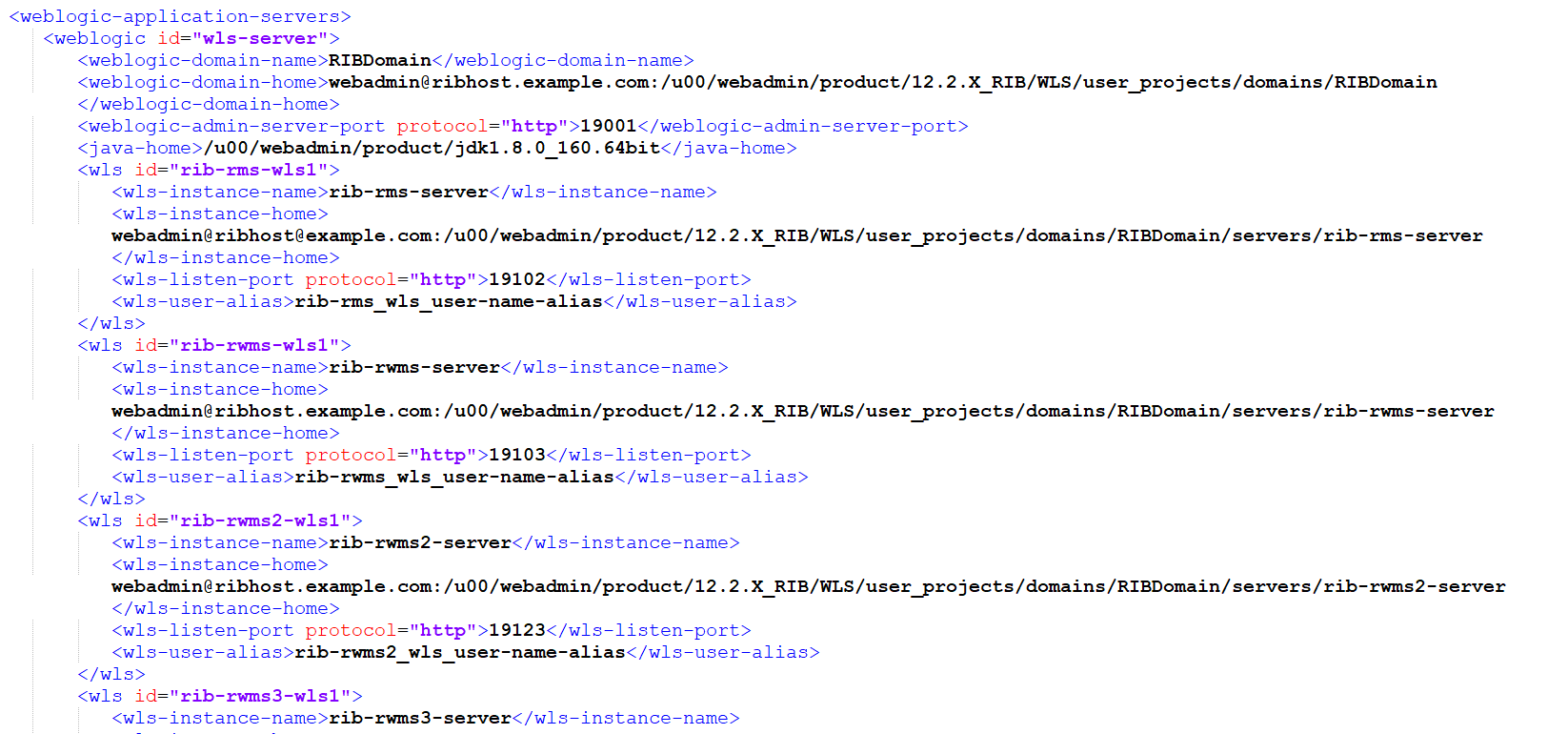
Configure the rib-applications section:
In this section you define the rib-<app> specific information for each rib-<app> that in scope.
For PL/SQL applications you must define the RIB Hospital connection, application database connections, and email notification information.

For Java EE applications, you must define RIB admin GUI information, RIB Hospital connection, email notification information, and the connecting retail application's (<app>) JNDI information.
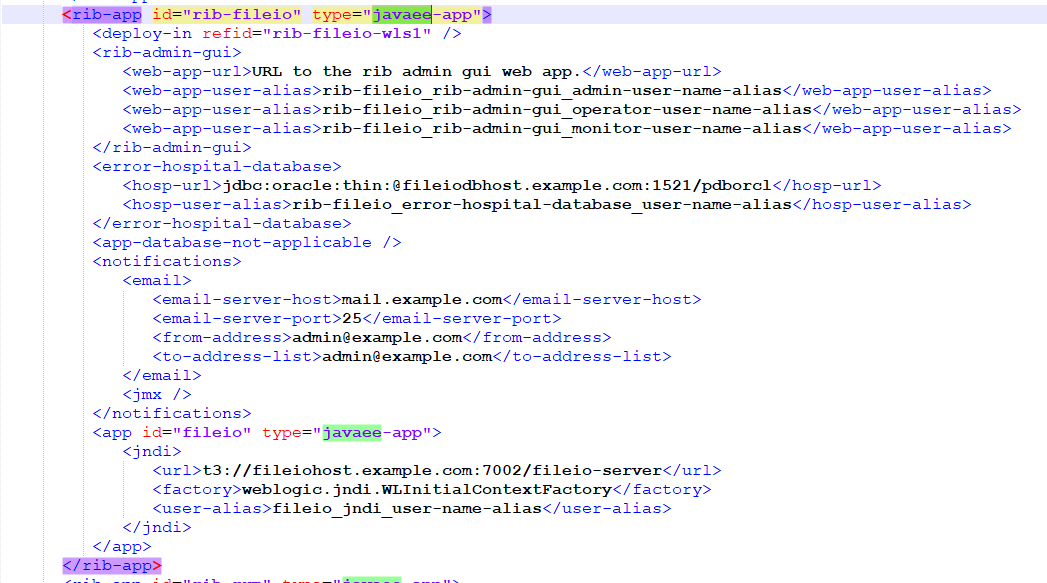
For SOAP application, you must define the RIB Admin GUI information, RIB Hospital connection, email notification information, and the end point application url information.
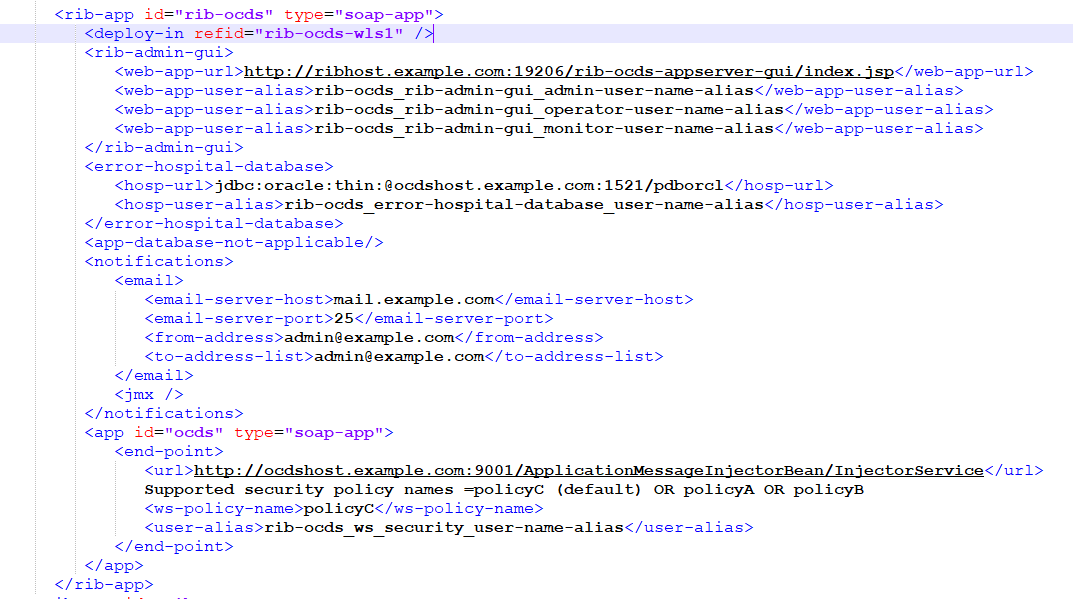
For master-plsql-app type applications, you must define the RIB Admin GUI information, RIB Hospital connection, email notification information, and slave end point application url information.
|
Note: For additional information, follow Chapter 7, "RIB-RWMS Hybrid Cloud Installation Instructions". |
Run the rib-home/application-assembly-home/bin/rib-app-compiler.sh script with set-up-security-credential from rib-home/application-assembly-home/bin directory.
Example: ./rib-app-compiler.sh -setup-security-credential

This will ask for user name and password information for aliases provided in the rib-deployment-env-info.xml file.
The user names and passwords are stored in a wallet file inside rib-home/deployment-home/conf/security directory.
Below are few screens which appears while executing rib-app-compiler.sh
JMS user name alias and password:
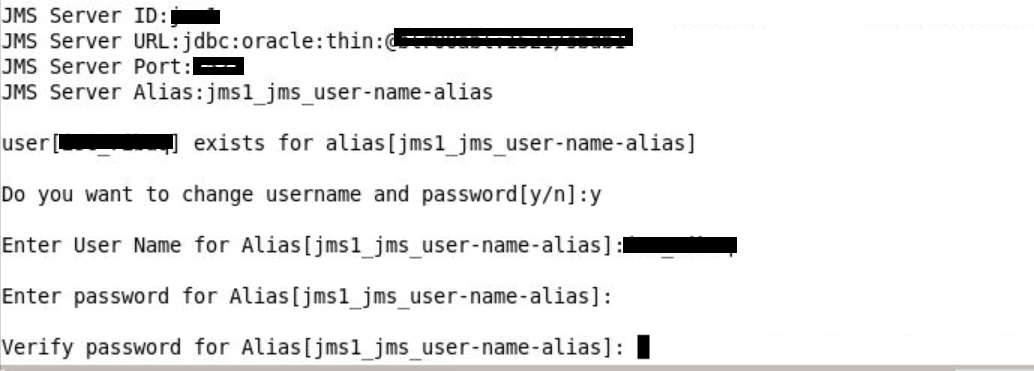
JNDI user name alias and password:


Rib-admin-gui username alias and password for admin role:

Rib-admin-gui username alias and password for monitor role:

Rib-admin-gui username alias and password for operator role:

Error hospital details:

WebLogic credentials:

After that this will generate/assemble a rib-<app> and make it ready for deployment
The RIB apps are now ready to deploy.
Log level change in "Log manager" page for any adapters can be restricted (read-only) by adding names of adapters as comma (",") separated value against key "disableLogLevelUpdatesForAdapter" in rib-<appName>.properties file located in rib-home/application-assembly-home/rib-<app>.
Example: disableLogLevelUpdatesForAdapter = Customer_pub
Below are list of properties file that are updated for current release
rib-ext.properties
Execute the rib-home/deployment-home/bin/rib-app-deployer.sh script with the appropriate com-mand line parameter.
This script is located in the rib-home/deployment-home/bin directory.
rib-app-deployer.sh -prepare-jms
This creates a new JMS server with all RIB configured topics.
>rib-app-deployer.sh -verify-error-hospital rib-<app>
This verifies the error-hospital database configurations by testing the connection to the database if the error-hospital tables are created in the schema.
|
Note: The database must be already running. |
rib-app-deployer.sh -deploy-rib-func-artifact-war

rib-app-deployer.sh -deploy-rib-app-ear rib-<app>

This deploys the rib-<app> to the Java EE container. Repeat this step for all rib-<app> that is in scope for this integration environment.
|
Note: <app> must be rms, rwms, tafr, sim, rpm, rsys, rce or aip. |
During the installation a shared library is created that contains the JDBC Driver update. It is necessary to bounce the wls instance.